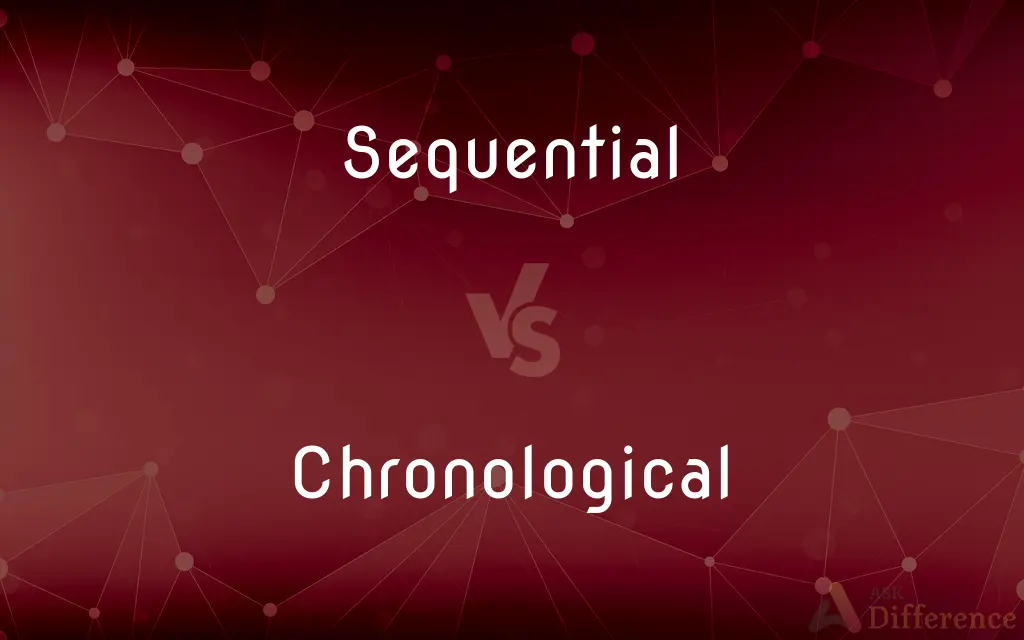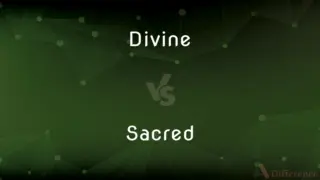Sequential vs. Chronological — What's the Difference?
By Tayyaba Rehman & Fiza Rafique — Updated on April 14, 2024
Sequential order follows a logical step-by-step progression, whereas chronological order specifically arranges events by their time of occurrence.

Difference Between Sequential and Chronological
Table of Contents
ADVERTISEMENT
Key Differences
Sequential order is about arranging content or events based on a logical progression where one step follows another. This can apply to instructions or processes where each stage is dependent on the preceding one. On the other hand, chronological order is used specifically to arrange events according to when they happened, from the earliest to the latest, and is often used in historical narratives or timelines.
In sequential ordering, the emphasis is on the sequence necessary to perform tasks or understand a concept, regardless of the time element. For example, steps in a recipe are sequential because one cannot proceed without completing the previous step. Whereas, chronological order might list events in the order they occurred, such as the milestones in the history of a company, focusing purely on timing rather than dependency.
Another aspect of sequential order is its applicability in various contexts, such as mathematical sequences or a series of actions in a manual. This type of order is crucial for understanding processes or workflows. On the other hand, chronological order is indispensable in studies like history or biography, where the sequence of dates is critical to comprehending the development over time.
Sequential logic can also refer to circuits or programming where operations occur in a defined order, crucial for the functioning of digital systems. On the other hand, chronological order can help in understanding timelines in documentaries or narrative, showing how one event leads to another over time.
Sequential order often has a conditional nature, with each step possibly affecting the next, used in problem-solving or troubleshooting guides. Chronological order, however, primarily serves the purpose of record-keeping and helps in understanding the progression or regression over time without necessarily impacting the sequence of future events.
ADVERTISEMENT
Comparison Chart
Definition
Follows a logical, step-by-step progression
Arranges events by their time of occurrence
Primary Use
Instructions, processes, programming
Timelines, histories, biographies
Emphasis
Dependency and procedure
Timing of events
Examples
Recipes, assembly manuals
Timelines, historical events
Importance in Context
Essential for understanding workflows
Critical for understanding historical developments
Compare with Definitions
Sequential
In succession, without interruption.
The tasks must be completed in sequential order to avoid errors.
Chronological
Involving the sequential progression of time.
The autobiography is written in a strictly chronological format.
Sequential
Pertaining to the sequence in data processing.
Sequential file access speeds up the data retrieval process.
Chronological
Arranged in the order of time.
The museum displays artifacts in chronological order.
Sequential
In mathematics, forming a sequence that follows specific rules.
The Fibonacci sequence is an example of a simple mathematical sequential pattern.
Chronological
Pertaining to chronology, the science of arranging events in their order of occurrence.
A chronological study provides insight into historical events.
Sequential
Forming part of a series with each part following the previous.
The assembly line adds parts to the product in a sequential process.
Chronological
Used to describe a record or narrative ordered by date.
The timeline chart is an effective chronological tool.
Sequential
Relating to a sequence, following a logical order of events.
The computer program executes commands in a sequential manner.
Chronological
Indicative of time-related sequence in storytelling.
Flashbacks disrupt the chronological flow of the narrative.
Sequential
Forming or characterized by a sequence, as of units or musical notes.
Chronological
Arranged in order of time of occurrence.
Sequential
Sequent.
Chronological
Relating to or in accordance with chronology.
Sequential
Succeeding or following in order.
Chronological
Relating to time, or units of time.
He is 67 in chronological age, but has the mind and body of someone 55.
Sequential
Expressing succession of events.
Chronological
In order of time from the earliest to the latest.
The live report lists all the events in chronological order.
Sequential
(programming) Executed as a sequence of instructions, without concurrency or parallelism.
Chronological
Relating to or arranged according to temporal order;
Chronological age
Sequential
Succeeding or following in order.
Sequential
In regular succession without gaps;
Serial concerts
Common Curiosities
Can sequential order be applied to historical events?
Yes, but only when presenting a process or development logically, rather than strictly by when each event occurred.
Is chronological order useful in technical contexts?
It is less common but can be useful for documenting the sequence of events in case logs or incident reports.
What is sequential order?
Sequential order is an arrangement where events or steps follow one after another based on logic or a set procedure.
What is chronological order?
Chronological order means arranging events exactly in the order they occurred, from the earliest to the most recent.
How does sequential order differ from chronological order?
Sequential order focuses on the logical progression of steps or events, while chronological order focuses strictly on timing.
How does sequential order benefit learning?
It helps by providing a structured approach, ensuring that foundational knowledge is built before advancing to more complex topics.
What is an example of sequential order in everyday life?
Following a recipe, where each step must be performed in a specific order to achieve the desired outcome.
What is an example of chronological order in everyday life?
A diary or journal, where entries are made according to the date on which each event occurred.
Is sequential order necessary in computer programming?
Absolutely, as it determines the execution order of code segments, which is essential for correct program operation.
Which is more useful for project management, sequential or chronological order?
Sequential order is more crucial for managing the steps and tasks within a project, while chronological order may help in tracking project milestones over time.
Why might an author choose to disrupt chronological order?
To create suspense, develop complex narratives, or reveal character development through flashbacks or non-linear storytelling.
Can a narrative be both sequential and chronological?
Yes, many narratives follow both orders, presenting events in a logical and time-based progression to enhance clarity and flow.
How does chronological order benefit historians?
It allows historians to track the progression of events and their impact over time, providing a clear temporal perspective.
What distinguishes sequential order in a narrative from chronological?
Sequential order in a narrative focuses on the causality and flow of events, while chronological order sticks to their timing.
What role does chronological order play in legal documents?
It's important for organizing events or evidence in a timeline that clearly shows the sequence of actions and their dates.
Share Your Discovery

Previous Comparison
Flight vs. Squadron
Next Comparison
Divine vs. SacredAuthor Spotlight
Written by
Tayyaba RehmanTayyaba Rehman is a distinguished writer, currently serving as a primary contributor to askdifference.com. As a researcher in semantics and etymology, Tayyaba's passion for the complexity of languages and their distinctions has found a perfect home on the platform. Tayyaba delves into the intricacies of language, distinguishing between commonly confused words and phrases, thereby providing clarity for readers worldwide.
Co-written by
Fiza RafiqueFiza Rafique is a skilled content writer at AskDifference.com, where she meticulously refines and enhances written pieces. Drawing from her vast editorial expertise, Fiza ensures clarity, accuracy, and precision in every article. Passionate about language, she continually seeks to elevate the quality of content for readers worldwide.
















































